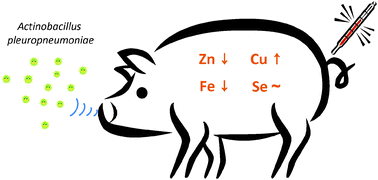Acute and subacute response of iron, zinc, copper and selenium in pigs experimentally infected with Actinobacillus pleuropneumoniae
Abstract
This study was performed to characterise the response of iron (Fe), zinc (Zn), copper (Cu) and selenium (Se) in bacterial-induced porcine acute phase reaction (APR). Twenty piglets were challenged by aerosolic infection with Actinobacillus pleuropneumoniae (A.pp.) serotype 2, ten piglets serving as controls. Blood sampling was done initially and at day 4 and 21 after infection, collection of liver tissue was done at day 21 (autopsy). A.pp.-infection caused fever and respiratory symptoms. APR at day 4 after infection was marked by an increase in total white blood cells, granulocytes and monocytes in whole blood samples and an increase in globulin/albumin ratio (G/A), α2-globulins, C-reactive protein, haptoglobin, ceruloplasmin (Cp), Cu and Se in serum. Concurrently, there was a decrease in haemoglobin (Hb) and packed cell volume (PCV) in whole blood as well as a decrease in albumin, transferrin, total iron binding capacity and Fe in serum and Zn in plasma. The subacute stage at day 21 was characterised by progressively increased concentrations of G/A, β-globulins and γ-globulins reflecting the specific immune reaction. Hb and PCV showed further decreases, all other parameters returned to the initial concentrations. Glutathione peroxidase activity in plasma and liver tissue remained unaffected by A.pp.-infection. The liver concentration (day 21) of Zn was found to be higher, that of Se was lower in the A.pp.-group, whereas hepatic concentrations of Cu and Fe were not affected by A.pp.-infection. In summary, the acute and subacute stages of A.pp.-infection were accurately characterised by the APR-related parameters. Se was only marginally affected by the A.pp.-infection. The elevated plasma Cu concentration may be a side effect of the transient hepatic induction of Cp synthesis. Zn responded, being distinctly reduced in plasma and probably having been sequestered in the liver tissue. Reduction in serum Fe can be regarded as an unspecific defence mechanism in A.pp.-infection to withdraw Fe from bacterial acquisition systems.


 Please wait while we load your content...
Please wait while we load your content...